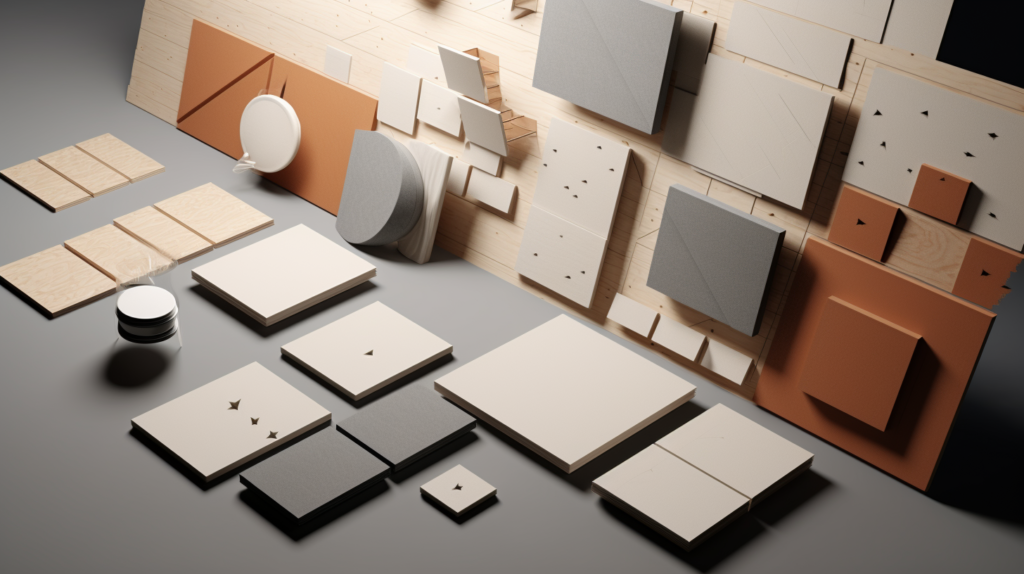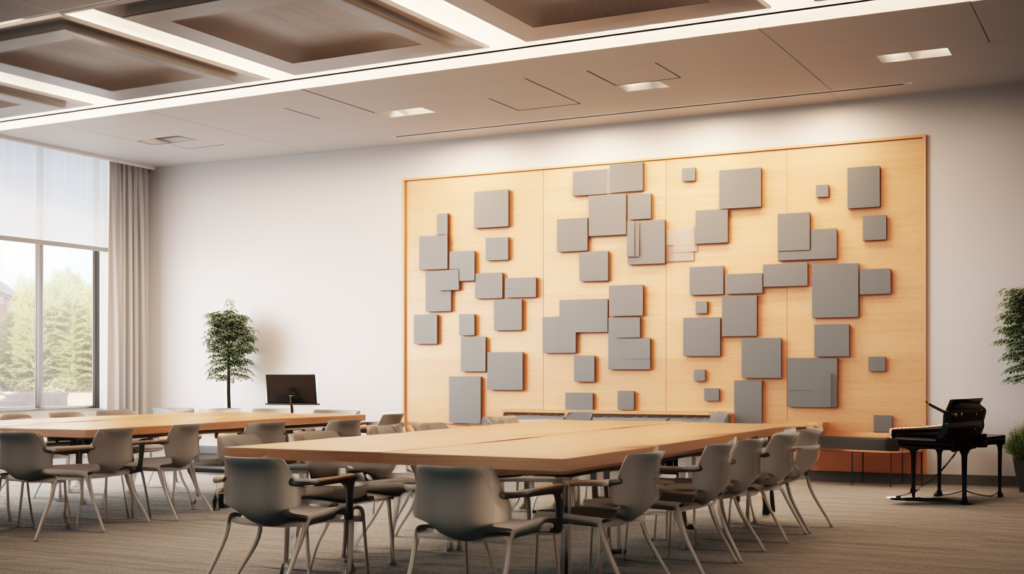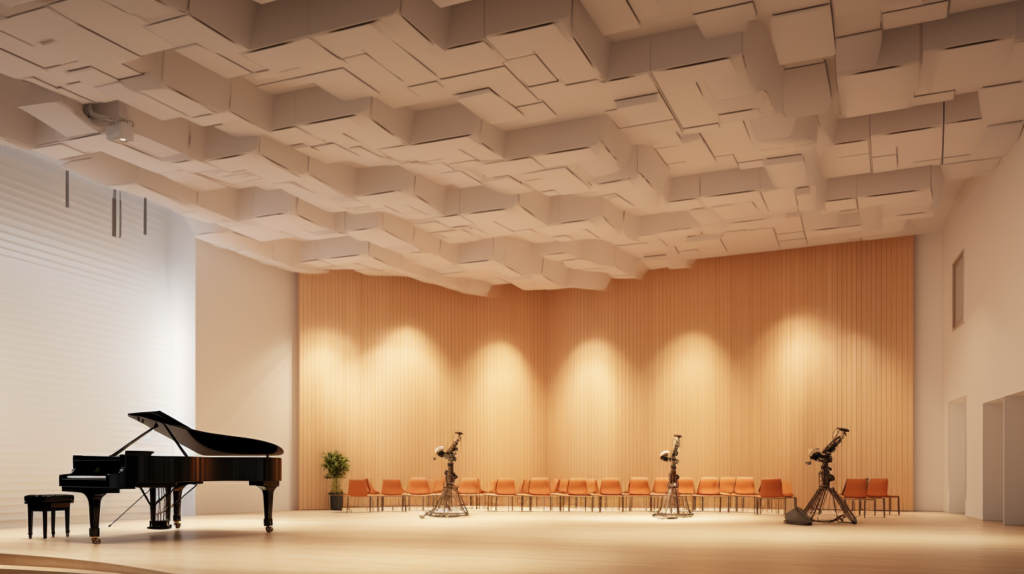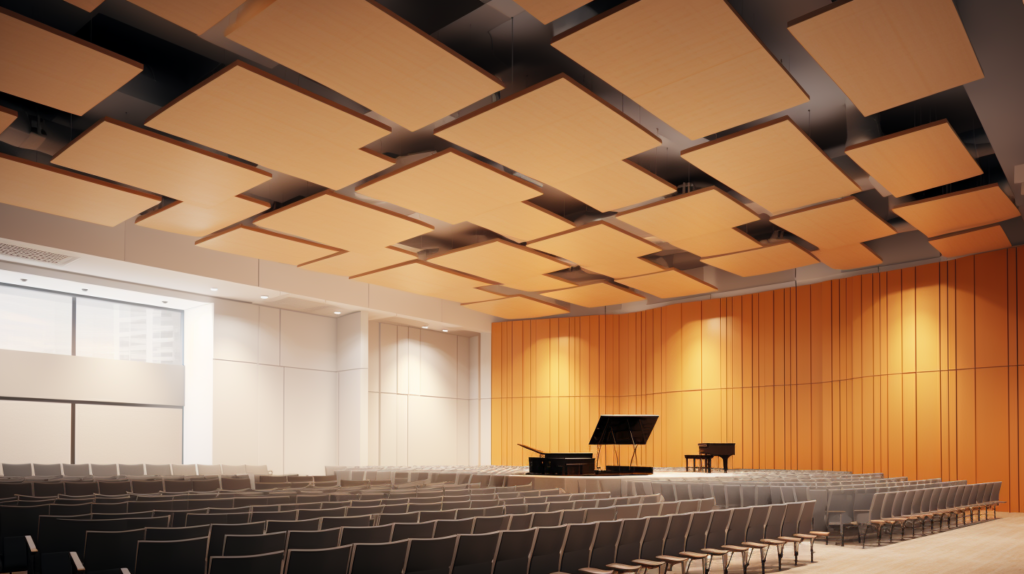Have you ever walked into a room and found it hard to understand what someone is saying because of the echoes, or perhaps struggled to appreciate a piece of music due to poor sound quality?
These are common issues that many people face but don’t know how to fix.
The world of acoustic treatments offers solutions to these problems through two main tools: acoustic panels and sound diffusers.
While both are designed to improve your auditory experience, they serve different purposes and are often confused with one another.
In this guide, we’ll unpack the key differences and applications of these two acoustic treatments.
Let’s dive in to help you make an informed choice for your unique auditory needs.
How Do Acoustic Panels and Sound Diffusers Individually Work?

This section will provide you with a comprehensive understanding of how acoustic panels and sound diffusers function.
Knowing the mechanism of action for each will help you make an informed decision when choosing between the two.
How Do Acoustic Panels Helps With Sound Absorption?
Acoustic panels are designed with the primary aim of absorbing sound waves.
They are constructed from materials that are effective at capturing and dissipating sound energy, converting it into minute amounts of heat.
This process reduces the amount of sound that gets reflected back into the room, thereby diminishing echoes and background noise.
Different materials have varying levels of effectiveness in absorbing sound.
Foam panels are a popular choice due to their affordability, but they may not be as effective as other materials for absorbing lower frequencies.
On the other hand, polyester acoustic panels offer both sustainability and effectiveness, making them a well-rounded choice for various applications.
Understanding the mechanism of absorption is crucial because it informs where and how acoustic panels should be used.
For instance, if you’re setting up a podcast studio, using acoustic panels on the walls behind and in front of the microphone can significantly reduce unwanted noise and reflections.
How Do Sound Diffusers Scatter Sound?
Sound diffusers function in a way that’s almost the opposite of acoustic panels.
Instead of absorbing sound, they scatter it, breaking up the sound waves and redistributing them throughout the room.
This action creates a more balanced sound field, making the room sound more natural and less echoey.
The science behind sound diffusion is surprisingly complex, involving intricate designs and precise calculations to ensure that sound is scattered effectively.
Unlike acoustic panels, which can be made from soft materials like foam or polyester, sound diffusers are usually constructed from hard materials like wood or plastic.
These materials are essential for the diffuser’s ability to scatter sound waves effectively.
While the concept of diffusion might seem simple, its impact on a room’s acoustics can be profound.
For example, in a home theater setup, sound diffusers can eliminate the ‘dead spots’ and ‘hot spots’ that often occur, ensuring that everyone in the room experiences high-quality sound.
What Are the Material Options for Acoustic Panels and Sound Diffusers?

Choosing the right material for your acoustic treatment is as crucial as deciding between absorption and diffusion.
Let’s delve into what options are available and how they impact sound quality.
What Materials Are Commonly Used in Acoustic Panels?
Acoustic panels are available in a variety of materials, each with its unique set of properties.
Foam panels are quite common and relatively inexpensive, but they may not offer the best performance for absorbing lower frequencies.
Fabric-wrapped fiberglass panels are another option, known for their effective sound absorption across a broad range of frequencies.
Among the various options, polyester acoustic panels stand out for several reasons.
They offer a high degree of sound absorption and are made from recycled materials, making them an eco-friendly choice.
In addition to their functional benefits, polyester acoustic panels are also versatile in terms of design and aesthetics, making them a popular choice for both commercial and residential settings.
Understanding the types of materials available for acoustic panels will guide you in selecting the best option for your specific needs.
If environmental sustainability is a priority for you, polyester acoustic panels could be an excellent choice.
Which Materials Are Preferred for Sound Diffusers?
In contrast to acoustic panels, sound diffusers are typically made from hard, reflective materials.
Wood is a traditional choice and is often used in high-end applications like concert halls and recording studios.
Polyester diffusers, made from high-density polymers, are also available and offer the advantage of being moisture-resistant, making them suitable for humid environments.
The material of the diffuser plays a significant role in its effectiveness.
Harder materials are less absorbent, which is crucial for a diffuser’s ability to scatter sound waves effectively.
So while you may have multiple choices in terms of design and aesthetics, the material’s acoustic properties should be a primary consideration.
How Do Aesthetic Considerations Factor Into Your Choice?

When implementing acoustic treatments, the functional aspect is of paramount importance, but aesthetics should not be overlooked.
After all, these treatments will be a visible part of your room.
How Do Acoustic Panels Fit Into Room Design?
Acoustic panels offer a wide range of customization options, both in terms of material and design.
Traditional foam panels, while effective, may not offer the most aesthetic appeal.
Fabric-wrapped panels provide an opportunity for incorporating various colors and patterns, allowing for a more cohesive room design.
Polyester acoustic panels take this a step further. Not only do they offer excellent sound absorption, but they are also available in a myriad of designs and colors.
You can even get them custom-printed with artwork or patterns that complement your room’s décor.
This means that your acoustic treatment can serve a dual purpose: improving sound quality while enhancing visual appeal.
The aesthetic versatility of acoustic panels makes them particularly well-suited for spaces where design is as important as function.
For example, in a corporate office setting, polyester acoustic panels can be used to reduce noise distractions while also serving as a design feature that reinforces the company’s brand.
What Aesthetic Roles Do Sound Diffusers Play?
Sound diffusers, while not as versatile in design options as acoustic panels, can serve as a unique visual element in a room.
Traditional wooden diffusers often feature intricate patterns and designs that can add a touch of sophistication to any space.
They are particularly popular in settings like concert halls and high-end home theaters, where both sound quality and visual appeal are important.
Though they may lack the color variety often available with acoustic panels, sound diffusers make up for it with their unique geometric designs.
These designs are not just for show; they are carefully calculated to provide effective sound diffusion.
Therefore, when choosing a sound diffuser, you are selecting both an acoustic treatment and a piece of art.
The aesthetic consideration is a crucial factor that can influence your choice between acoustic panels and sound diffusers.
While acoustic panels, particularly polyester ones, offer more design flexibility, sound diffusers can serve as eye-catching focal points in a room.
Where Should You Use Acoustic Panels and Sound Diffusers?

Now that we’ve covered the mechanisms, materials, and aesthetics, let’s discuss the practical applications.
Your specific needs will largely dictate whether acoustic panels or sound diffusers are the right choice for you.
What Scenarios Are Best Suited for Acoustic Panels?
Acoustic panels are versatile and can be used in a variety of settings, but they are especially effective in environments where sound clarity is a priority.
For example, in a recording studio, you’ll often find acoustic panels placed strategically around the room to reduce sound reflections and provide a clearer audio capture.
In corporate settings, open-plan offices can be particularly noisy, making it difficult for employees to focus.
Installing polyester acoustic panels can significantly reduce ambient noise, contributing to a more productive work environment.
Their versatility in design options also allows them to integrate seamlessly into the existing décor.
Acoustic panels are also commonly used in educational institutions, particularly in lecture halls and auditoriums.
In such large spaces, echoes can make it challenging for students to understand what’s being said, affecting the learning experience.
Polyester acoustic panels offer an effective and eco-friendly solution in such scenarios.
When Should Sound Diffusers Be Used?
Sound diffusers are particularly effective in larger spaces where the goal is to enrich the sound environment.
Concert halls and theaters often use sound diffusers to scatter sound waves, creating a more immersive experience for the audience.
In residential settings, sound diffusers are an excellent addition to home theaters and high-fidelity listening rooms.
Unlike acoustic panels, which aim to absorb sound, diffusers maintain a room’s natural liveliness, which can be particularly important for enjoying music.
The application of sound diffusers isn’t just limited to entertainment or professional spaces.
They can also be beneficial in public spaces like airports or train stations.
By scattering sound waves, diffusers can help distribute announcements more evenly throughout the area, making them easier to hear and understand.
What Are the Advantages and Disadvantages of Using Acoustic Panels and Sound Diffusers?

While both acoustic panels and sound diffusers offer a range of benefits, they also come with their own set of challenges. Understanding these can help you make a more informed decision.
What Are the Benefits and Drawbacks of Acoustic Panels?
Acoustic panels offer a range of advantages, starting with their effectiveness in reducing ambient noise and echoes.
This makes them ideal for environments where sound clarity is a priority. Polyester acoustic panels, in particular, are highly effective and offer the added benefit of being eco-friendly.
Another advantage of acoustic panels is ease of installation. Most panels come with mounting hardware or adhesives, making it possible to install them yourself.
Additionally, they are available in various designs and colors, providing ample opportunity for aesthetic customization.
However, acoustic panels are not without their drawbacks. One of the primary challenges is the risk of over-absorption, which can make a room sound “dead” or “muffled.”
This is especially a concern in spaces like music studios, where a certain level of natural reverberation is often desirable.
Overuse of acoustic panels can also lead to a room that is too quiet, which might not be suitable for all settings.
What Are the Benefits and Drawbacks of Sound Diffusers?
Sound diffusers excel in environments where the goal is to maintain or enhance a room’s natural ambience.
They are particularly useful in larger spaces like concert halls, where the richness and fullness of sound are important.
Another benefit is that sound diffusers, unlike acoustic panels, do not absorb sound energy. This means they do not contribute to making a room sound “dead.”
Instead, they help maintain a lively acoustic environment, which can be important in settings like music venues or theaters.
However, there are challenges associated with using sound diffusers. One significant drawback is the complexity of installation.
Diffusers often come in larger sizes and can be quite heavy, requiring professional installation.
They are also generally more expensive than acoustic panels, both in terms of the product itself and the cost of installation.
What Factors Should Guide Your Decision Between Acoustic Panels and Sound Diffusers?

While the advantages and disadvantages of each offer a good starting point, additional factors such as room size, acoustic goals, and budget should further guide your decision.
How Does Room Size and Shape Influence Your Choice?
The dimensions of your space can significantly affect the effectiveness of acoustic treatments. In smaller rooms, issues like flutter echoes and standing waves are more prominent.
Acoustic panels, particularly those made of polyester, can be very effective in treating these problems.
In larger spaces, like concert halls or open-plan offices, the challenges are different.
Here, sound diffusion can be more beneficial, helping to distribute sound energy more evenly throughout the room.
Sound diffusers are generally more effective in larger spaces, especially where the goal is to enrich the sound experience rather than just reduce noise.
What Are Your Acoustic Goals?
Your specific acoustic needs should also be a significant factor in your decision-making process.
If your primary goal is to improve speech intelligibility, such as in a conference room or lecture hall, then acoustic panels are generally more effective.
Polyester acoustic panels, for instance, offer excellent sound absorption properties that can help clarify spoken words.
On the other hand, if you’re looking to enhance a room’s natural acoustic properties, sound diffusers are likely a better fit.
They can add a level of depth and richness to music, making them ideal for music venues and home theaters.
How Does Budget Impact Your Decision?
Last but certainly not least is the issue of budget. Acoustic treatments can range from relatively inexpensive to quite costly, depending on the materials and installation requirements.
Acoustic panels, particularly those made from polyester, are generally more budget-friendly.
They are also easier to install, potentially saving on labor costs. Sound diffusers, on the other hand, are usually more expensive due both to the cost of the materials and the complexity of installation.
When To Use A Sound Diffuser vs A Sound Absorber?

Sometimes, the best way to understand the impact of acoustic treatment is to see it in action.
Let’s explore some case studies that highlight the effectiveness of acoustic panels and sound diffusers in various settings.
How Have Acoustic Panels Improved Office Environments?
One compelling case study involves a corporate office that struggled with noise distractions in an open-plan setting.
After installing polyester acoustic panels on the walls and ceiling, employees immediately reported a notable improvement in their ability to concentrate.
Not only did the acoustic panels serve their primary function of reducing ambient noise, but they also enhanced the overall aesthetic of the office.
The panels were custom-designed to match the company’s branding, serving as both a functional and decorative element.
What Impact Have Sound Diffusers Had in Concert Halls?
In another case, a well-known concert hall was experiencing issues with sound clarity, particularly in the upper seating areas.
After installing wooden sound diffusers along the back wall and ceiling, both musicians and audience members noted a significant improvement in sound quality.
The diffusers effectively scattered the sound waves, creating a more evenly distributed sound field.
This improved the listening experience for everyone, regardless of where they were seated in the hall.
Conclusion
Choosing between acoustic panels and sound diffusers comes down to your specific needs, room characteristics, and budget.
Acoustic panels, especially polyester ones, are versatile and cost-effective for sound absorption.
Sound diffusers, while more complex and costly, excel in enriching a room’s natural acoustics
In some scenarios, a mix of both may offer the best acoustic solution. This guide aims to equip you with the knowledge to make an informed decision that enhances your space’s auditory experience.
Frequently Asked Questions (FAQ) About Acoustic Panels and Sound Diffusers?
When it comes to acoustic treatments, people often have questions about the suitability, interchangeability, and maintenance of acoustic panels and sound diffusers.
Let’s address some of these common queries.
Can Acoustic Panels and Sound Diffusers Be Used Interchangeably?
While both acoustic panels and sound diffusers aim to improve the acoustic quality of a room, they serve different functions and are generally not interchangeable.
Acoustic panels, including those made of polyester, are designed primarily for sound absorption.
They are effective in reducing echoes and background noise, making them ideal for environments where clarity is essential.
Sound diffusers, on the other hand, are intended to scatter sound waves, enhancing the acoustic environment by making it sound more natural and balanced.
They are particularly useful in larger spaces like concert halls, where a rich and full sound is desirable.
What Kind of Maintenance Do These Treatments Require?
Both acoustic panels and sound diffusers are relatively low-maintenance. Polyester acoustic panels can be easily cleaned with a damp cloth and are resistant to moisture and mildew.
This makes them an excellent choice for environments where hygiene is a concern, such as healthcare facilities.
Sound diffusers, usually made from harder materials like wood or plastic, may require occasional dusting but are generally quite durable.
Because they don’t absorb sound (and thus don’t absorb contaminants in the air), they are relatively easy to maintain over the long term.
